“E’ proprio quando credete di sapere qualcosa
che dovete guardarla da un’altra prospettiva.
Anche se può sembrarvi sciocco o assurdo,
ci dovete provare.” (da “L’Attimo fuggente”)
So benissimo che parlare di questo potrà sembrarvi banale, prevedibile, e forse un po’ noioso. E a dirla tutta, anche io ci ho pensato un po’ su, prima di decidere cosa volevo scrivere. E cosa si può scrivere, che non sia già stato detto, a proposito della Festa d’Autunno più famosa del mondo (insieme ad Halloween)?
Io credo di saperlo, e speriamo vi piaccia l’idea.
Sì, perché mi rendo perfettamente conto che molti di voi saranno venuti qui a Monaco in occasione di questa festa magari anche più di una volta, e che quindi avranno vissuto questi giorni pazzi senza aver bisogno di me o delle mie spiegazioni.
Quindi immagino che in molti sappiate che l’Oktoberfest esiste da più di duecento anni, per la precisione dal 1810, anno di inaugurazione. Saprete che fu allestito per celebrare il matrimonio del principe Ludovico di Baviera e della principessa Teresa_di_Sassonia-Hildburghausen e che fu in realtà una corsa di cavalli: solo dopo il successo di quel primo, grande evento si decise di ripeterlo annualmente e via via vennero aggiunte fiere agricole, momenti di danze popolari, tanta musica e un luna park ogni anno più grande.
Non vi sarà nemmeno sfuggito, se siete un po’ curiosi come me, che fu annullato durante le due guerre mondiali e in occasione di epidemie varie, e che negli anni si è persa la tradizionale corsa dei cavalli, che ora sfilano per le strade agghindati come re e più o meno pronti a farsi fotografare.
Il nome probabilmente viene proprio dal fatto che la prima volta ebbe luogo nel mese di Ottobre, ma in realtà oggi si svolge nelle ultime due settimane di Settembre, e arriva fino ai primi giorni del mese successivo.
Quest’anno si è iniziato il 19 Settembre e si andrà avanti fino al 4 Ottobre. Il luogo è sempre lo stesso, Theresienwiese, una zona verde davvero enorme, tanto che questo evento è praticamente la fiera più grande del mondo!
Tutti, ma proprio tutti voi – anche chi non è mai venuto di persona – potete capire quanta confusione, allegria, gente, passi di qui ogni santo Oktoberfest. Tantissima. Tantissimo di tutto. Quindi anche di questo non è proprio il caso di parlare, non vi pare?
E di che parliamo, allora? Ecco, a me piacerebbe parlare delle differenze.
Delle sensazioni – come al mio solito – così diverse tra l’Oktoberfest vissuto di giorno e quello vissuto la sera, tra cosa è per noi e cosa invece significa per un bavarese purosangue. Differenze. Che sembrano dettagli e che invece sono il profumo della festa. Almeno per me.
Ci sono andata più volte, in quell’inferno spensierato, per capirne il segreto, il sapore, la passione. E’ lì che ho capito che di sapori, la Wiesn (il nome che i bavaresi danno a questo evento), ne ha più di uno. Di certo via via con gli anni si sarà persa un po’ di tradizione, ma ancora oggi è una manifestazione affascinante e per molti versi, tuttora autentica.
Quest’anno ci sono andata la prima volta di sera, con Christian e un nostro amico, Igor, un ragazzo che io adoro, con la sua simpatia, il suo italiano imperfetto e quel pizzico di pazzia che lo rende (troppo) simile a me.
Ti colpiscono subito le luci accecanti, le giostre altissime, tanto che noi tre siamo stati a lungo a guardare il cielo e quei poverini che gridavano di paura e divertimento sulle “giostre della morte” alte fino alle nuvole.. il mio unico pensiero era “ma come fanno, con tutta quella birra che avranno in corpo!”.
Mi hanno detto, tra le altre cose, che le montagne russe sono le più alte del mondo e che se per caso durante l’anno qualcuno ne costruisce di più grandi, l’anno dopo gli organizzatori faranno in modo di “rimediare”, realizzandone di nuove per non perdere il primato: illuminate sono qualcosa di fenomenale (ma io non faccio testo, mi si conquisterebbe anche con due lumini.. adoro i “luccichini”, che posso farci!)
Poi cammini, ti guardi intorno e vedi ragazzi e ragazze che sorridono, urlano, si trascinano – capiteli, qui la birra si vende in boccali da un litro! – parlano, fotografano, cantano. Mai visti i bavaresi così. Quasi sembrano italiani (quasi!), anche se nonostante la confusione e l’alcol continuano a chiedere scusa e a dire grazie per qualsiasi cosa!
E poi, ecco, ti capita di entrare in uno dei Festzelte (i tendoni della festa, gli stand della birra insomma) e lì ci trovi l’anima.
Sono immensi, come forse saprete, possono ospitare fino a quindicimila persone, hanno tavoli e panche in legno e sono addobbati ognuno con colori diversi: al centro di ogni stand è allestito un palco, dove una banda suona musica che di sera non è poi cosi tradizionale, visto che suonano anche canzoni inglesi che conosco anche io! Si mangiano piatti bavaresi, si beve birra ovviamente, si canta molto.
Sapore di vita, di festa gridata, di divertimento puro senza pensieri, sembra davvero di essere in un posto a parte, dove tutto lascia spazio all’allegria, al momento. Sembra davvero una festa di matrimonio. Incredibile.
Noi tre abbiam mangiato, bevuto, cantato, e fatto mille foto: ci piaceva guardare i bavaresi vestiti col costume tradizionale, quasi tutti, ci piaceva l’atmosfera giovanile e la grande voglia di divertirsi e di festeggiare. Ecco, loro festeggiano, di sera.
Ora, come spiegarvi l’Oktoberfest con la luce del sole? La prima cosa che mi viene in mente è il sorriso della gente. Diverso da quello dei ragazzi della notte.
Di giorno, la festa ha altri colori. Un’altra cosa, e non lo dico solo io. Il numero di persone è sempre esagerato – tra bavaresi e turisti ogni anno passano di qui tra i 6 e i 7 milioni di persone – ma secondo me è diverso un po’ tutto.
Per esempio, le attrazioni principali non sono le montagne russe, o i vari giri della morte, ma le case dell’horror, quelle sullo stile Indiana Jones, quella carinissima che ti porta “nel futuro”. Insomma, la ricerca del divertimento che non abbia necessariamente a che fare col “pericolo”, ma piuttosto con la voglia di esplorare nuove o vecchie dimensioni. Io personalmente ho amato tutto ciò che ho fotografato, sia di notte che di giorno, il luna park è qualcosa di straordinario, credetemi!
Certo, ci sono anche i turisti, e anzi so che proprio a questo scopo si parla di “settimana degli italiani” e “settimana degli inglesi”: troverete molte offerte vantaggiose per venire qui e viaggi organizzati a prezzi contenuti. Si dice che sia una sorta di “omaggio” che Monaco fa all’Italia soprattutto, visto il contributo che gli italiani hanno dato a queste zone in ambito gastronomico.. insomma, siamo bravi a “fa’ da magna’!”. E allora grazie mille! La settimana degli italiani dovrebbe iniziare proprio oggi, quindi pensateci..
In realtà ci trovi gente da tutto il mondo, spagnoli, americani, australiani, ovviamente giapponesi, etc. ed ecco che è facile fare amicizia, ballare e cantare e mangiare con persone che non hai mai visto e che invece sembrano amici tuoi da sempre.. come in ogni grande celebrazione che si rispetti, del resto. Pane per i miei denti – ché quando sono in vena parlo anche con i muri.
Quando sono tornata la seconda volta era dunque giorno; ero con due amiche, Lola e Klara, meravigliose e costernate da così “tanta roba”. Che belli i loro occhi sopresi, i loro sorrisi di gioia, le loro esclamazioni!
La prima volta all’Oktoberfest è così, non ci si può far nulla!
Ovvio che anche di giorno si beva moltissima birra, che tra l’altro è venduta solo negli stand, mentre nei chioschi trovi panini, dolci e caffè ma bibite e altre bevande. Però l’aria è differente, molta gente compra ricordi e souvenir nei piccoli negozietti sparsi per le strade, molti si accomodano a bere espressi e a mangiare dolci caramellati e ciambelle fritte: sapore di qualcosa di più familiare, sapore di tradizione, di unicità. Non sto dicendo che sia più bello rispetto alla sera, solo diverso.
Diversa la gente, diversa la musica (che di pomeriggio negli stand è musica bavarese principalmente) diversa l’allegria. Quello che resta di identico è la moltitudine di colori, i loro meravigliosi costumi, i gesti tradizionali che ritrovi, è le mille lingue che senti parlare contemporaneamente, è la voglia di esserci, lì, col cuore.
E’ proprio per una questione di cuore, che ho scelto di parlarvi dell’altra grande differenza, quella che passa tra i visitatori occasionali e i bavaresi, ai quali questa festa appartiene davvero.
Perché loro la vivono con un animo diverso da quello del turista più o meno per caso, non è solo un modo di divertirsi bevendo e cantando. E’ la loro storia, l’orgoglio di un popolo che ama le proprie radici, i gesti ripetuti, i riti tramandati.
Se si chiede a qualcuno di Monaco cosa è per lui o per lei l’Oktoberfest, non ti risponderà mai “la festa della birra”. Mai.
Io ho chiesto, approfittando del fatto che abito qui e che quindi conosco la gente del posto, per potervi raccontare qualcosa che non fosse solo la manifestazione in sé per sé, ma proprio l’amore che c’è dietro tutti i boccali, i piatti di Schweinshaxe (lo stinco di maiale tipico di questi luoghi), i costumi, le giostre, la musica.
La prima cosa che mi hanno risposto, ad esempio, è che questa è la celebrazione di Monaco di Baviera e della sua gente , i festeggiamenti, a distanza di secoli, per ricordare il matrimonio del re Ludovico I, il nonno paterno del loro adorato re Ludwig II (quello dei castelli famosi, per intenderci). La seconda, che è impossibile pensare alla città senza questo festival popolare, che l’autunno inizia solo e soltanto con l’Oktoberfest, e che la bellezza è nei dettagli.
Mi hanno spiegato che per lavorare come cameriera è obbligatorio essere bavarese. Nessun altro può servire i clienti, impossibile. Sono loro le “padrone” di casa, donne in grado di servire fino a 8 Maß (il tipico boccale da un litro) col sorriso smagliante, il costume scollato, e due braccia forti che quasi mettono paura!
Che guadagnano molto, in questi quindici giorni, è una cosa che aggiungo io.. però lavorano, ragazzi, e quanto!
Robert mi ha raccontato che per allestire i Bierzelte, un altro modo di chiamare gli stand, ci vogliono circa tre mesi, e che ovviamente solo le birre di Monaco possono essere protagoniste: i marchi sono sei, se non sbaglio, (Paulaner, Augustiner, Hofbräuhaus, Lowenbrau, Hacker-Pschorr, Spaten) e la loro tradizione storica è davvero di lunga data. Lui le conosce nei dettagli e te le descrive in un modo che ti incanta, perché non sembra stia parlando di birra, ma di un’opera d’arte.
Mi ha spiegato che è doveroso, mentre si cammina per le strade della Theresienwiese, andare a dare un saluto alla Bavaria, la bronzea statua femminile simbolo della regione, alta 18 m, dalla cui sommità si può godere di una vista stratosferica su St. Paul Kirche.
A tavola, Herr Franz mi ha insegnato il punto preciso in cui, durante una determinata canzone popolare, bisogna alzare in alto i boccali in un simbolico, gigantesco brindisi, perché “questo è il gesto autentico ed esatto per rendere onore ad una festa così”.
E tutti, tutti coloro cui ho chiesto, mi hanno parlato della cerimonia di apertura, quando il sindaco di Monaco spilla la prima birra, e se non ho capito male deve inserire un rubinetto nella grande botte adibita usando un martello, dando grossi colpi fino a che il rubinetto si incastra: solo allora il Sindaco pronuncia la sua frase di rito. Ovviamente in dialetto bavarese.
“O’Zapft is”, che letteralmente è un po’ complicato da tradurre, ma che sta per “La festa abbia inizio. Divertitevi”.
Sabrina
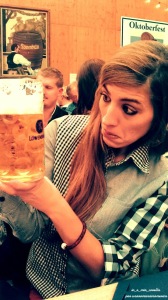
“Just when you think you know something,
you have to look at in another way.
Even though it may seem silly or wrong,
you must try”
(from “Dead Poet Society”)
I perfectly know that this subject may appear obvious, predictable and perhaps also a little boring. And honestly, I also had to carefully think about it, before choosing what to write. And what else could be said about the most famous Fall Festival in the world (together with Halloween)?
I have an idea and I hope you will enjoy it.
Yes, I perfectly understand that maybe some of you already came to Munich during this festival, maybe more than once, and that spent crazy days here without needing me and my explanations.
So, I guess that you already know that the Oktoberfest has been alive and kicking for more than two hundred years and precisely, it started in 1810, the year of its inauguration.
You will probably also know that the Oktoberfest began as a celebration of the marriage of Crown Prince Ludwig of Bayern to Princess Therese of Saxony- Hildburghausen. Actually it started as a horse race and since it was a success, then it became an annual festival. Over the years they added agricultural shows, folk dances, a lot of music and an amusement park, that becomes bigger each year.
If you are curious like me, you’d know that the Oktoberfest wasn’t held during the two World Wars and during severe outbreaks and there is no more the traditional race horse. Horses only parade in the streets dressed like kings and ready to take pictures with people.
Probably its name comes from the fact that the first time it took place in the month of October, but actually nowadays it takes place in the last two weeks of September, until the first days of October.
This year it started September 19 and will end Octber 4 The setting is always the same, Theresienwiese, a really big green park, so much that the festival deserves the nomination as the biggest festival in the world!
So now all of you, even those who never came here, can easily understand how much confusion, cheer and people pass by here every Oktoberfest. A lot. A lot of everything. So, I think this is not something to truly talk about, right?
So, what will be our point, then? Well, I would like to talk about what’s different.
Which are the feelings that can mark living the Oktoberfest during the day and living it in the night and what it could mean to me, as a foreigner and what it means for a true Bavarian. Differences. That seem like small details but actually I think they are the core of the festival. At least for me.
I went there many times, in order to capture all its secrets, its flavors, its passion. And there I understood that the Wiesn – as Bavarians call the Oktoberfest – has many shades. Obviously over the years the traditions got lost a little bit, but still it remains a fascinating and authentic festival, in many ways.
This year I went there in the evening first, together with Christian and our friend Igor, an adorable guy, with his cordiality, his imperfect Italian and that little bit of craziness that makes him so similar to me.
You are immediately captured by the blinding lights and the sky-high rollercoaster. So much that we spent a long time staring at the sky and at those poor guys who were crying of fear and enjoyment on such “death rollercoaster”, up in the clouds…My only thought was: “How can they do it, with all the beer they have been drinking!”
Someone told me that this rollercoaster is the highest in the world and if during the year, someone else builds a rollercoaster higher than this, well, the Oktoberfest organizers will make sure to build a new, higher one. These rollercoasters are amazing, especially when they are full of lights (ok, for me usually also a pair of candles would work…)
And then you walk around and you are surrounded by boys and girls who laugh, scream, drag themselves (well, you see, they sell you beer in one liter mug), talk, take pictures and sing. I never saw Bavarians behave like that. They almost look Italians (almost!), even if, despite confusion and alcohol, they keep on apologize and say “thank you” for everything!
And then, you just enter one of the Festzelte (German for “festival tents”, “beer tents”) and you find the true heart of the festival.
As you probably know, they are very big and can house up to 15.000 people. There are wooden tables and benches and each one is decorated in a different color. At the centre of every stand there is a stage, with bands playing music that especially in the evening, is not too much traditional, since they play also English songs that I know! You have the chance to eat typical Bavarian dishes, drink beer – of course! – and sing a lot.
It tastes like life, like loud parties and pure, carefree enjoyment. It really feels to be in a world on its own, where all is happiness and living for the moment. Like a wedding party. Incredible.
We ate, drank, sang and took tons of pictures. We enjoyed watching Bavarian people wearing their traditional costumes – almost everybody did – we loved the youthful atmosphere and the way everything was all about having fun and celebrate. There you go, that’s how they rock it in the night.
During the day, the Oktoberfest has different colours. It’s something different, and I’m not the only one who says so. There’s always a lot of people – every year about 6 or 7 million people come here, both tourists and people from Bavaria – but I feel that in the sunlight everything is different someway. For example, main attractions are not roller coasters, but horror houses, those in Indiana Jones style, those very nice houses which bring you to the future. So, during the day people look for fun which doesn’t necessarily have to do with danger but simply with the exploration of new or old dimensions. I loved everything I took the picture of, both at night and during the day, and the fair is wonderful, believe me!
Ok, there are a lot of tourists, actually there are the “italian people’s week” and the “english people’s week” , so you can find a lot of special offers and be granted discounts to come here and enjoy the Oktoberfest. It’s said this is some sort of homage Munich pays to Italy, for what Italian people did for this area in terms of food… Well, we, the Italians, we are good at making food! So thank you, Munich.
Italian people’s week is going to start so…think about it.
Here you meet tourists and people from all over the world, spanish people, Americans, people from Australia and, obviously, Japanese people. It’s easy to make new friends, to dance, to sing and eat with people you have never seen in your life but are like friends.
The perfect atmosphere for me, who talk with walls also, when I’m on top form.
When I came here for the second time, it was during the day. I was with two friends of mine, Lola and Klara, surprised by this “great stuff”. How wonderful their surprised eyes, their smiles and their exclamations. This is the typical reaction of a person who visits the Oktoberfest for the first time. During the day also, you drink a lot of beer, and in kiosks you can find sandwiches, cakes, coffee and other drinks. But the air and the atmosphere are different, people buy souvenirs in little shops, take a break and sit to drink an espresso or to eat delicious fried donuts and cakes with caramel, which are unique and traditional flavours. I’m not trying to say that all this is more exciting compared with what happens at night, but only different. People is different, music is different (in kiosks, music is mainly Bavarian), happiness is different. What doesn’t change are the colours, the wonderful dresses, the traditional gestures, all the languages you hear at the same time, and the joy for being there, with all your heart. Actually, it’s because of heart that I decided to talk about the real difference, the one that exists between occasional tourists and Bavarian people, who are really fond of the Oktoberfest. They live it in a different way compared with tourists, Oktoberfest for them is not only another way of drinking and singing. Oktoberfest is their history, it’s the pride of people who love their roots and traditions.
If you ask a person in Munich “What’s Oktoberfest for you?”, she will neves say “A beer fest”. Never. I asked, since I live here and I know the people, so I can tell you something that goes over the fest itself, I can tell you about the love you find behind the beer steins, the Schweinshaxe dish (the pork shank, typical of these places), the dresses, the fair, the music. The first thing people say is that this is the celebration of Munich and its people. These celebrations are in memory of king Ludwig I’s marriage, Ludwig II’s grandfather, the one of the famous castles. The second thing they say is that it’s impossible to imagine the city without the Oktoberfest, that autumn only starts with the Oktoberfest, and that its beauty is in the details. They explained that, if you want to work as a waitress, you have to be Bavarian, otherwise you cannot serve customers. Bavarian people are the “bosses”, those who can serve up to 8 Maß (the typical German stein) with a dazzling smile and two strong arms which almost make you feel scared. They earn a lot, in two weeks, but they work a lot!
Robert told me that setting up the Bierzelte, another name for booths, takes about three months and, obviously, only beers from Munich are the protagonists of the fest. There are 6 brands, if I’m not mistaken, (Paulaner, Augustiner, Hofbräuhaus, Lowenbrau, Hacker-Pschorr, Spaten) and they have a very long tradition. Robert knows them in detail and describes them in a way that is fascinating, it seems he’s not talking about a beer but a work of art.
He said that, when walking in the streets of the Theresienwiese, you have to go and say Hello to the Bavaria, the bronze statue of a woman, symbol of the region. It’s 18m tall and from the top you can see a wonderful panorama of the St. Paul Kirche. As for eating, Herr Franz told me when I had to lift the stein while listening a song and eating. This is some sort of a great “Cheers” and it’s the typical gesture people do to pay homage to a fest like this. And when I asked, everyone talked about the opening ceremony, during which the major of Munich pours the first beer (if I’m not mistaken, he has to put a tap in a great barrel using a hammer and he has to hit it until the tap is well stuck in the barrel) and says the typical sentence, in Bavarian, “O’Zapft is”. It’s a little bit complicated to translate this sentence but, literally, it means “THE FEST STARTS, ENJOY IT!”.
Traduzione a cura di Daniela Masciotra e Chiara Ferri
Transalated by Daniela Masciotra and Chiara Ferri
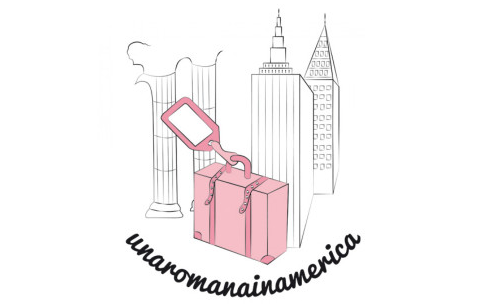
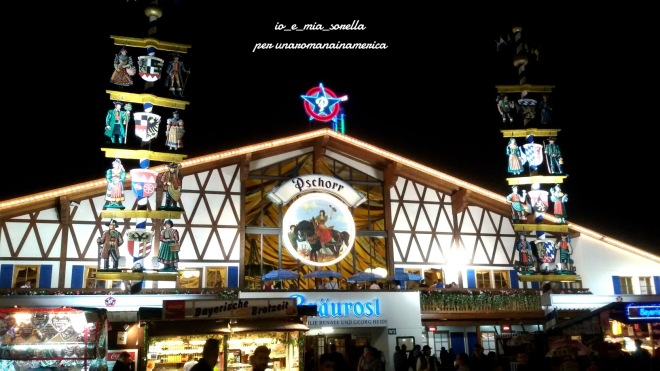





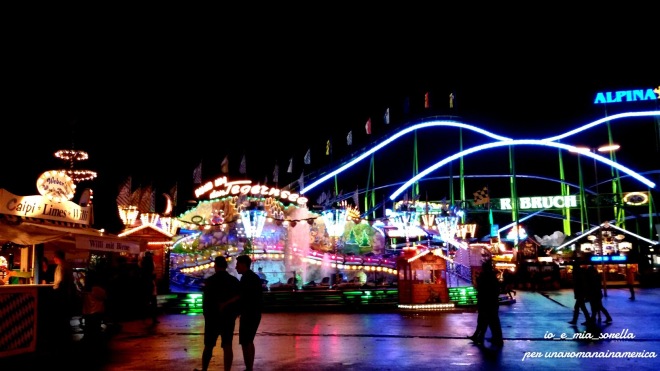
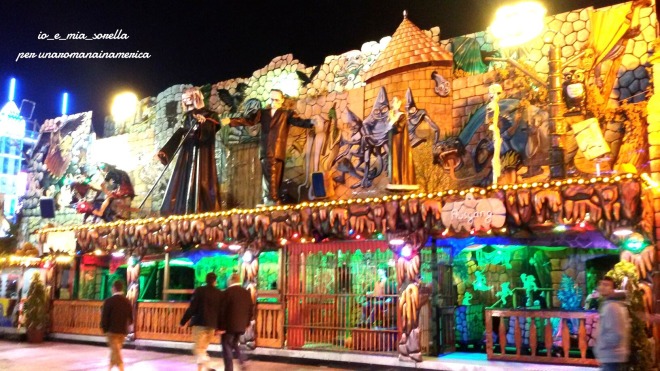
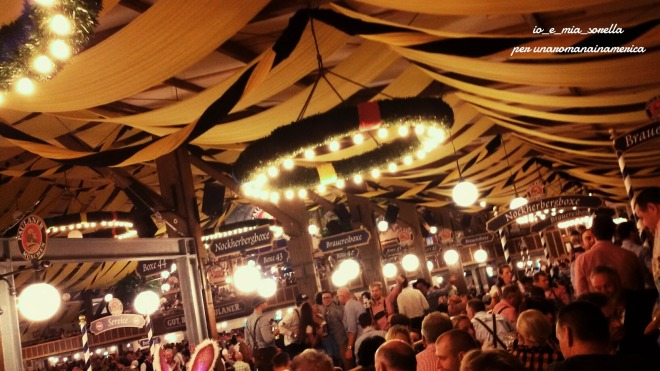








Stupenda, ogni anno dico che ci voglio andare è ancora non ci sono mai stata…però prima o poi la devo vivere dal vivo questa festa 😊😊😊
Ciao Ely
sì, ti consiglio di venire! Come dicevo l’atmosfera è davvero unica, e ci sono così tanti aspetti diversi da osservare, che è praticamente “un’esperienza” più che una festa!!
Ti auguro di riuscire l’anno prossimo, ma se sei libera ricorda che l’evento si chiude il 4 Ottobre, quindi hai ancora un po’ di tempo.. sai che si dice dei viaggi improvvisati: sono sempre i migliori!
Ah, dimenticavo, se puoi, non venire durante il week end, c’è meno “verità” e davvero troppa confusione!!
Un abbraccio e grazie mille,
Sabrina